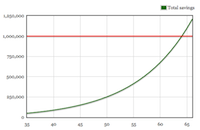What caught my eye this week.
I think sequence of return risk is perhaps the least discussed Most Important Thing about investing.
That’s probably because it doesn’t impact professionals so much.
Big institutions such as pension funds and endowments typically have an infinite time horizon. There’s no cliff edge for them where they move from saving to spending – which is the cut-off point where sequence of returns risk can do the most damage.
Individual fund managers? Well, they do face a related career risk. The best thing for a poor-to-average fund manager is to achieve your great returns early on, in order to attract a lot of assets. You can then revert to the mean with your mediocre-to-bad years later, when you’re earning a fat fee on all those billions.
Of course this is the opposite of what would be best for the average investor in that fund, but that’s a topic for another day.
Anyway Ben Carlson of the Wealth of Common Sense blog published an excellent deep dive into sequence of return risk this week, noting:
The sequence of returns in the markets is something we have no control over.
Some investors are blessed with weak returns in the accumulation phase and strong returns when they have more money, while others are cursed with brutal bear markets at the outset of retirement or markets that go nowhere when they have a bigger balance.
Luck plays a larger role in investment success than most realize since we each only have one lifecycle in which things play out.
Oh yes, that’s yet another reason why we don’t hear much about sequence of returns risk – there are no perfect ways to counter it. Even the good and sensible ones are likely to sap your returns. (Like diversification, however, they can still be perfectly sensible things to do).
See Ben’s full article for some ideas on managing sequence of returns risk.
And have a great Bank Holiday!


